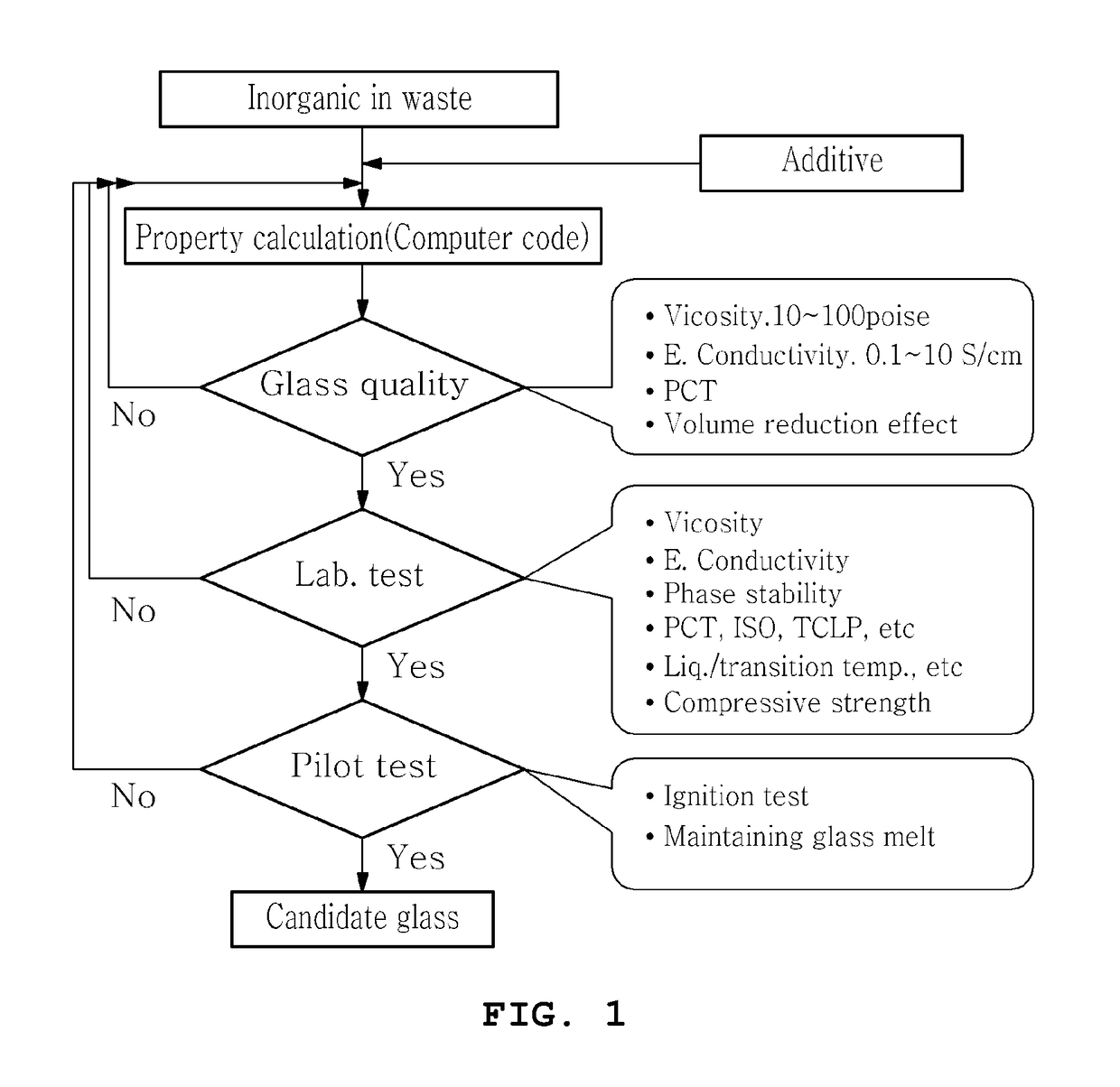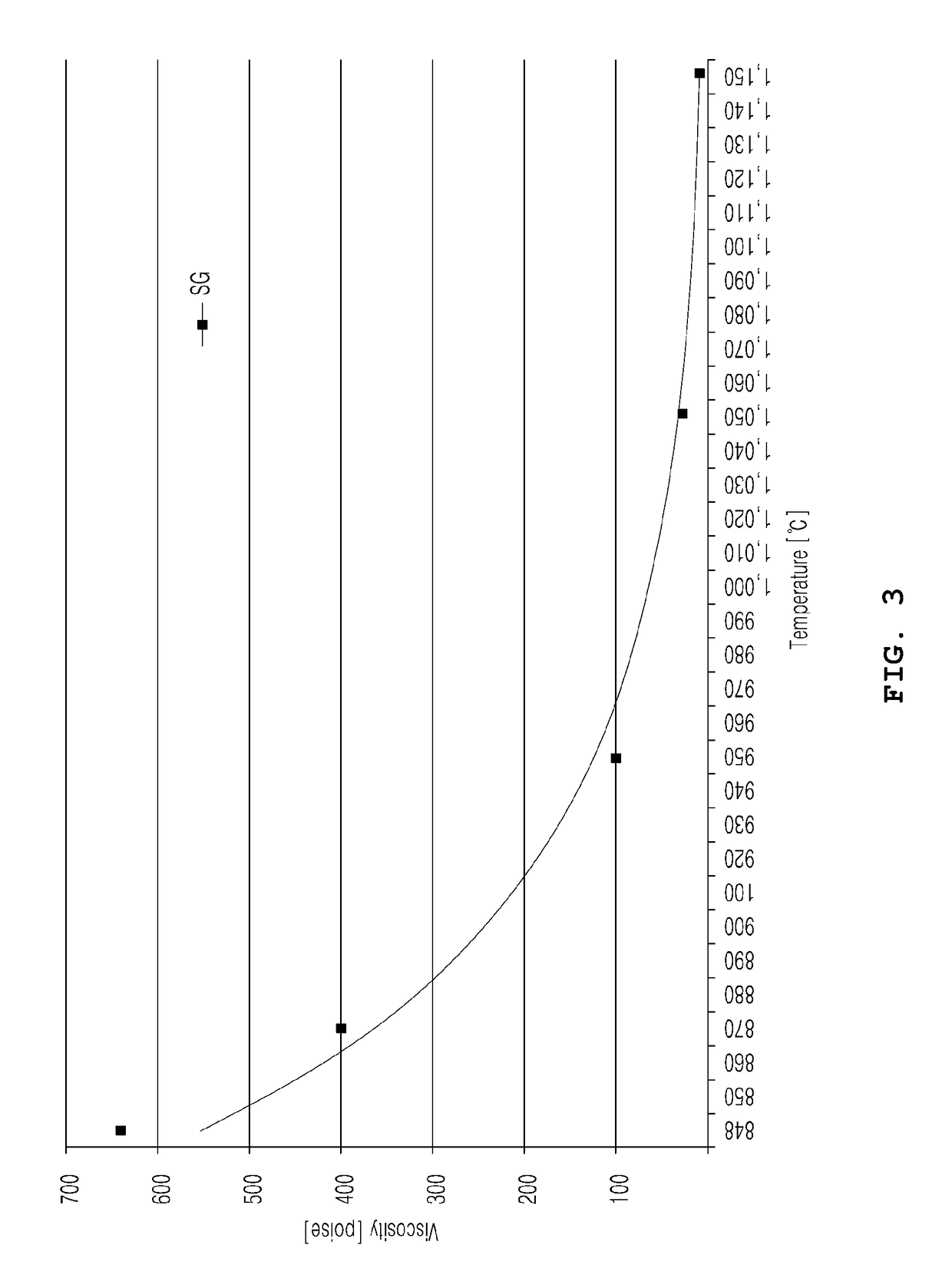Glass composition for vitrifying flammable waste products
a technology of flammable waste products and glass compositions, applied in the direction of radioactive decontamination, nuclear engineering, solid waste disposal, etc., can solve the problem that the technology of vitrifying high-level waste products cannot be applied to middle- and low-level radioactive waste products without any modification, and achieve the effect of reducing the volume of radioactive waste products
- Summary
- Abstract
- Description
- Claims
- Application Information
AI Technical Summary
Benefits of technology
Problems solved by technology
Method used
Image
Examples
example 2
nt of Candidate Glass (Simulation of Glass Composition)
[0030]In order to vitrify the target waste products for vitrification, AG8W1 was selected as the candidate glass of the mixed waste product (hereinafter, referred to as ‘W1 waste product’), DG-2 was selected as the candidate glass of the flammable waste product (hereinafter, referred to as ‘dry active waste’), and SG was selected as the waste resin using GlassForm 1.1 computation code. The components and main properties are described in Table 1.
[0031]
TABLE 1Properties of base glass frit and candidate glass (values at 1,150° C.)W1 waste Dry active wasteproductBase / candidateWaste resinBase / candidateglassBase / candidateglassDG-glassAG8AG8W12BaseDG-2SG-BSGAl2O314.4212.308.007.077.57.36As2O51.040.62————B2O38.579.9715.0011.2915.0010.59BaO———0.04——CaO—4.82—9.77—18.1CeO21.040.62————CoO0.520.31—0.01——Cr2O3——————Cs2O——————CuO———0.01—2.86Fe2O3—1.78—0.35—2.86K2O—1.632.004.47—7.3Li2O2.071.247.005.257.505.13MgO—2.120.504.63—2.22MnO2—0.05—0.17—...
experimental example 1
nical Properties
[0032]The viscosity, electric conductivity, phase homogeneity, liquidus temperature, transition temperature, softening point, thermal expansion coefficient, and compressive strength of the AG8W1 candidate glass of the W1 waste product, the DG-2 candidate glass of the dry active waste, and the SG candidate glass of the waste resin, which were selected in Example 2, were tested as follows.
[0033](1) Viscosity and Electric Conductivity
[0034]From FIGS. 2 and 3, it was confirmed that the viscosity of the DG-2, AG8W1, and SG candidate glass was in the required range of 10 to 100 poise at the operating temperature of 1,150° C. when measured. Further, from FIGS. 4 and 5, showing the result of measurement of electric conductivity, it could be seen that all of the DG-2, AG8W1, and SG candidate glass satisfied the required value of electric conductivity at 1000° C. or higher.
[0035](2) Phase Homogeneity and Liquidus Temperature
[0036]When the glass is melted over a long period of ...
experimental example 2
[0047]The molten solidified body, which is formed during the vitrification process, must be chemically stable in intermediate storage and final waste disposal environments. The most main reason why glass is selected as a treatment medium of radioactive waste products among many other materials is that glass prevents radioactive materials from leaking into the environment and is capable of storing the radioactive materials for a long period of time due to the excellent chemical robustness thereof. Accordingly, the selected candidate glass compositions were tested and analyzed using the internationally certified leaching test methods in order to compare and evaluate the chemical stabilities of the molten solidified bodies. In order to perform a robustness comparison with the glass selected by the Nuclear Environment Technology Institute, the high-level R7T7 candidate glass of France and the SRL-EA benchmark glass of the USA were tested together.
[0048](1) TCLP (Toxicity Characteristic ...
PUM
| Property | Measurement | Unit |
|---|---|---|
| electric conductivity | aaaaa | aaaaa |
| viscosity | aaaaa | aaaaa |
| liquidus temperature | aaaaa | aaaaa |
Abstract
Description
Claims
Application Information
 Login to View More
Login to View More - R&D
- Intellectual Property
- Life Sciences
- Materials
- Tech Scout
- Unparalleled Data Quality
- Higher Quality Content
- 60% Fewer Hallucinations
Browse by: Latest US Patents, China's latest patents, Technical Efficacy Thesaurus, Application Domain, Technology Topic, Popular Technical Reports.
© 2025 PatSnap. All rights reserved.Legal|Privacy policy|Modern Slavery Act Transparency Statement|Sitemap|About US| Contact US: help@patsnap.com



